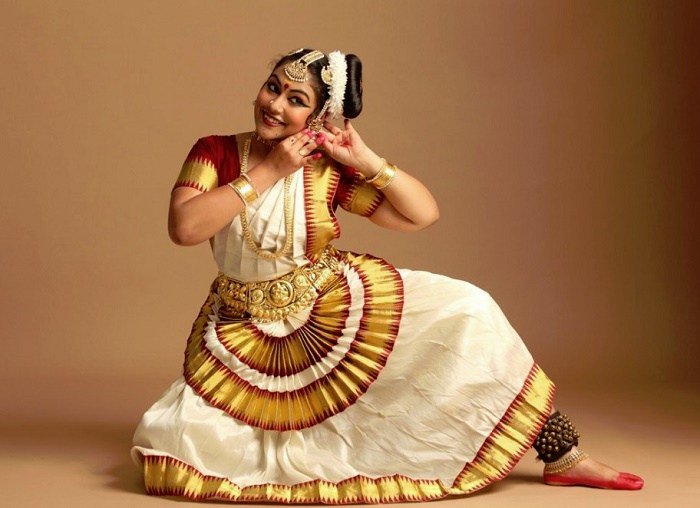Source of all Images in this Blog-post : Google Images : ‘Google Image Search’ will reveal the multiple sources of every single image shared in this Blog. For more details, kindly see ‘Disclaimer‘


Mohiniyattam, is one of the eight classical dances of India that developed and remained popular in the state of Kerala. Kathakali is another classical dance form of Kerala.
Mohiniyattam dance gets its name from the word Mohini – a historical enchantress avatar of the Hindu god Vishnu, who helps the good prevail over evil by developing her feminine powers.


Bharatanatyam Temple Jewellery Designs on Instagram & Where To Shop Online


Mohiniyattam’s roots, like all classical Indian dances, are in the Natya Shastra, the ancient Hindu Sanskrit text on performing arts.
However, it follows the Lasya style described in Natya Shastra, that is a dance which is delicate, eros-filled and feminine. It is traditionally a solo-dance performed by women after extensive training.



The repertoire of Mohiniyattam includes music in the Carnatic style, singing and acting a play through the dance, where the recitation may be either by a separate vocalist or the dancer herself.
The song is typically in Malayalam-Sanskrit combo.The earliest mention of the word is found in the 16th-century text Vyavaharamala, but the likely roots of the dance are older.



The dance was systematized in the 18th century, was ridiculed as a Devadasi prostitution system during the colonial British Raj, banned by a series of laws from 1931 through 1938, a ban that was protested and partially reappealed in 1940.
The socio-political conflict ultimately led to renewed interest & revival of Mohiniyattam by the people of Kerala, particularly the poet Vallathol Narayana Menon.



With the spread of colonial British rule in the 19th century India, all classical dance forms of India were ridiculed and discouraged, leading to their severe decline. This was in part the result of the Victorian morality of sexual exploitation along with Christian missionaries who criticized Hinduism.

The seductive gestures and facial expressions during temple dances were caricatured in ‘The Wrongs of Indian Womanhood’, published in the beginning of 20th century, as evidence of harlots, debased erotic culture, slavery to idols and priests tradition etc.
Christian missionaries demanded that this must be stopped, launching the ‘anti-dance movement’ in 1892.
This movement affected all classical dance forms in India and hugely contributed to their decline, including the ban of Mohiniyattam in the princely states of Travancore and Cochin during the British Empire.
Some women continued to dance Mohiniyattam in Hindu temples, regardless of the historic politics during the 1940s.

The ridicule and bans enacted during the British colonial era impacted all Hindu performing arts including Mohiniyattam.
The costume includes plain white or off-white such as ivory or cream colored Sari embroidered with bright golden or gold laced colored brocade.
The vocal music of Mohiniyattam involves various rhythms. There are numerous compositions for a Mohiniyattam repertoire, most of whose lyrics are a mixture of Sanskrit, Tamil and Malayalam.
The musical instruments usually used in Mohiniyattam are Mridangam or Madhalam (barrel drum), Idakka (hour glass drum), flute, Veena, and Kuzhitalam (cymbals).
Bharatanatyam Temple Jewellery Designs on Instagram & Where To Shop Online
